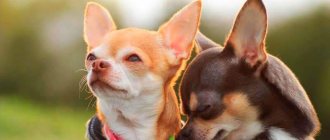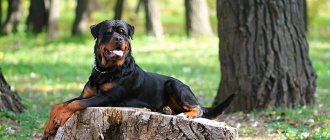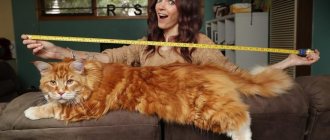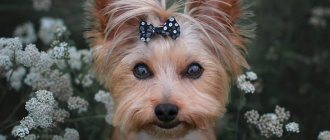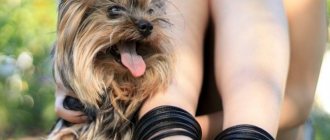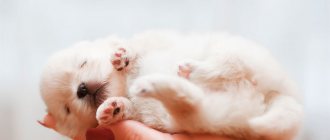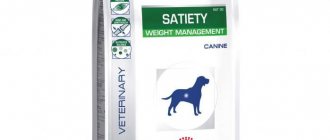One of the common questions that worries pug dog owners is whether the pet’s weight is normal or overweight? This is explained by the fact that pugs have a tendency to gluttony, which leads to obesity. The breed cannot independently control the amount of food it eats. Therefore, the owners must take responsibility for this. Drawing up a diet, determining the daily feeding rate, preventing the dog from overeating - all this should be under the strict control of the owner.
How long does it take for pug dogs to grow and gain weight? What is the normal weight for adult pets and puppies? At what indicators is a pug considered underweight and overweight? We have collected the answers to all these questions in our material.
How to measure a dog's size
To correctly measure the size of your dog you need to:
- do this at the same time of day and before the animal eats;
- the frequency of measurements depends on the age of the baby. So, at two months and earlier, measurements are taken every five days, from two to six months - every ten days, at six months and older - every month;
- Body weight is measured using ordinary scales. First you need to stand on them yourself and record the indicator. Then stand up with your pet in your arms. The difference between the two numbers is the dog's weight;
- To measure the dog's height, you need to take a measuring tape and place it vertically from the floor to the very top of the withers.
First vaccinations
Vaccinations for puppies begin at 7-11 weeks. 10 days before the immunization procedure, deworming is carried out with anthelmintic drugs. Repeat the course of treatment with antiparasitic drugs every 4 months.
First, puppies are given a 5-valent injection for hepatitis, leptospirosis, distemper, parvovirus and adenovirus. After 4 weeks, the dogs are revaccinated against 5 infections carried out at eight weeks of age, supplemented with a remedy for parainfluenza. The anti-rabies drug is used annually.
Before vaccination, you should not take your pet outside. It is allowed to walk the pug in the summer in the arms of the owner. 10 days before vaccination, contact with animals is prohibited. The procedure can only be postponed during illness or when the dog’s baby teeth are changing.
After vaccinations, the puppy sometimes experiences general malaise, swelling and pain in the injection area, increased body temperature, and lethargy. If symptoms persist for more than 3 days, it is worth visiting a veterinarian.
Pug weight table by age
The table below shows the weight of a pug puppy by month.
| Dog age | Pet gender | |
| Male (in kilograms, +/- 400 g) | Female (in kilograms, +/- 400 g) | |
| At 2 months | 2 kg | 2 kg |
| At 3 months | 3 kg | 3 kg |
| At 4 months | 4 kg | 4 kg |
| At 5 months | 5 kg | 5 kg |
| At 6 months | 6 kg | 6 kg |
| At 7 months | 7 kg | 6.5 kg |
| At 8 months | 8 kg | 7 kg |
| At 9 months | 9 kg | 7-7.3 kg |
| At 10 months | 10 kg | 7.3-7.6 kg |
| At 1 year | 11-12 kg | 8-9 kg |
| At 2 years old | 11-12 kg | 8-9 kg |
| At 3 years old | 11-12 kg | 8-9 kg |
| At 4 years old | 11-12 kg | 8-9 kg |
Development and growth rate
As a toy breed, Pugs are not very tall. Average animal height:
- Boys - 30-35 cm at the withers.
- Girls – 25-30 cm at the withers.
“Ideal weight” varies slightly depending on the standards of cynological associations:
- Canadian club: boys – 8.1 kg, girls – 6.3 kg.
- American Club: boys – 8.2 kg, girls – 6.4 kg.
In body shape, pugs are “square dogs”: the height at the withers and the length of their bodies are approximately equal. These are dense, well-built, muscular animals with a stocky build. At the same time, a puppy with normal weight has a free and easy gait.
In order for the kitten to develop fully and not acquire diseases and pathologies, you should adhere to simple rules:
- Set a strict diet and feeding schedule for the dog. It is best to consult a veterinarian.
- Make sure your dog leads an active lifestyle. Walks with the puppy should take at least 1 hour. Joint jogging with the owner, playing ball or frisbee are required. Another form of staying in great shape is swimming. However, not all pugs love water activities.
- Track the puppy’s weight, compare personal indicators with the average. Do not ignore strong deviations.
- Visit a veterinarian for a preventive examination at least once every six months.
If you follow these general rules and individual recommendations from a specialist, you can provide your pug with a happy life of at least 12-15 years.
Why is a pug skinny?
If your pet weighs very little, this can be explained by several reasons:
- Malnutrition. The most dangerous thing is malnutrition in puppies that are just beginning to grow.
- The dog has no appetite. There may also be reasons for this.
- Infection with worms. This is a fairly common reason. To avoid damage to the body by parasites, you need to systematically deworm your dog.
- Lack of vitamins. Again, their deficiency has the greatest impact during puppyhood. Such a baby will grow up sick and weak.
Price
The cost of puppies depends on the region of purchase, age, color and pedigree. The price of dogs of ordinary colors (red, beige, silver) is 10,000-12,000 rubles, and small black pugs cost from 15 thousand to 20 thousand.
Pet-class puppies without a famous family are purchased for 10,000-15,000 rubles. The presence of a pedigree, documents, and the dog’s compliance with all standards increases this figure to 20,000-60,000 rubles.
Most nurseries have websites where they post photos of animals, supplemented with all the necessary information about them. Buying a pug online reduces the price to 8,000-9,000 rubles.
Obesity in pugs
This is a very common problem in Pugs. Therefore, the owner should not give in to slack and treat the pet with food from his own table. Pugs are small dogs, so they gain excess weight quickly. Starting from a young age, the puppy should eat only according to a strict schedule, without unscheduled “snacks”. In order not to miss the onset of the disease, it is necessary to systematically weigh the animal.
However, the cause of obesity is not always severe overeating. Sometimes this is facilitated by disturbances in the functioning of the endocrine system, lack of physical and physical activity, and old age.
Factors influencing growth
The rate of growth and development of a puppy depends on many things:
- Genetic factor, heredity.
- Environment, living conditions at a young age.
- Balanced diet.
- Sufficient physical activity.
- Timely deworming - helminthic infestation inhibits the development of puppies.
It is important to ensure that the kitten does not suffer from an excess or lack of vitamins and mineral elements:
- Vitamin D deficiency is the cause of rickets, bone deformation, and developmental delays.
- The correct ratio of calcium and phosphorus is 1.2:1. An excess of calcium is also a reason for the slow development of an animal.
Diet tips
Feeding pug puppies
Veterinarians and dog handlers advise feeding small puppies with ready-made dry food, as it contains a properly balanced amount of vitamins. Around seven months or a little earlier, you can gradually switch your baby to natural food (if desired).
If the owner decides to feed the puppy natural products, he must correctly calculate the daily portion and do not forget about adding vitamin complexes to the diet.
If the owner decides to feed the baby food, you need to buy products of at least premium class, since economical budget granules are dangerous to the health of the animal.
Nutrition for an adult dog
The pug does not have chewing teeth, so it is necessary to cut meat and other food given to the pet into pieces. Meat should be cut larger, other products smaller.
In general, the pug diet should look like this:
- Raw lean meat - at least 2/3 of the entire diet.
- Boneless fish (only sea and lean fish) – 1-2 times a week.
- Sour milk - every day.
- Boiled vegetables, finely chopped fruits - every day.
- Thick buckwheat, rice and oatmeal porridges – 1-2 times a week. It is allowed to season with a piece of butter (or a spoonful of vegetable oil).
You cannot mix natural food with dry ready-made granules. Prohibited foods for dogs are:
- pasta and other flour products, including bread and pastries;
- semolina;
- fatty foods;
- smoked food;
- potatoes in any form;
- sugar and sweet products (sweets, lollipops, etc.).
Pugs love to eat, they can do it all day long. Surely, when you sat down at the table for dinner or simply decided to snack on something tasty, you noticed how a pug immediately appeared next to you with such an unhappy expression in his eyes that it was simply impossible to resist. Don't fall for the dog's tricks. It’s worth sharing a piece of something tasty once, but in the future the pet will simply sit on your neck and get used to begging for food.
From the very beginning, strictly ensure that no one from the household gives the “poor hungry dog” a single piece from the table. A piece a day will lead to plump barrels in a couple of months. Read here what to feed your pug. Feed the animal correctly, following the diet.
Pugs are muscular and quite dense dogs, but they should not have excess fat. Excess weight will lead to cardiovascular diseases, which will negatively affect your pet's life expectancy.
Your pug gains excess weight unnoticed; try to weigh your pet monthly.
Diet for Overfed Pugs
Diet is the main weapon in the fight against obesity in your pet. And to use it effectively, you need to know the rules for creating a healthy dog diet:
- It is strictly forbidden to give an overweight pug the usual canned food. The exception is a special dietary one, which contains a full range of nutrients.
- Reduce your daily food intake by 10%. We divide the number of feedings by four per day instead of the usual two. If the pet has become obese due to old age, then the frequency of feedings, on the contrary, decreases to once a day, or remains usual - twice a day. In the morning, the old pug is given light food like egg yolk or vegetables and porridge. And in the evening they give you lean fish or poultry.
- Among the permitted products are: white poultry meat, lean fish, kefir and other fermented milk. In addition, you need to increase your consumption of vegetables.
- It is necessary to add vitamins and minerals to the baby’s daily diet.
Another component of treating obesity in a pet is increasing activity. The duration of daily walks should not be less than an hour. You need to unfasten the leash more often and let the baby run freely. Active games will also come in handy. For example, with a ball or a stick. Veterinarians recommend sending your baby swimming, because while swimming in the water, he receives an even load on all muscles. But if the pug doesn’t like water, you can’t insist.
Preparing a place for a future pet
Before the dog settles in a new home, the owners need to create comfortable conditions for its stay - prepare a sleeping area and a feeding area. The right decision would be to immediately teach the baby to rest separately. This will save you from future problems with disciplining your pug. You can familiarize yourself with the rules for raising a pug in this article.
To place the basket, choose a quiet corner of the apartment. There should be no radiators or heaters or drafts nearby, because temperature changes can weaken the dog’s immunity. The size of the sleeping place, convenient for the animal to rest, is 50 by 70 cm. According to hygienic requirements, it is better to protect the mattress of the bed with a cover.
The kitchen is suitable for organizing a feeding area. It is enough to select a small corner, which is covered with oilcloth. A bowl with a volume of 0.6-1 liters for food is placed on top of it. There is a bowl for water nearby. For older four-legged animals, the dishes are secured with a tripod.
Expert opinion
Anna Abramenko
An avid dog lover. Experience in veterinary medicine since 2009.
Ask a Question
A pug bed should be placed in the living room, otherwise the puppy may feel abandoned. Therefore, you should not install the dog’s resting place in storage rooms, on balconies or in niches.
Deviations from the norm
Of course, deviations from normal body weight can be represented by both obesity and dystrophy, but the second option is less typical for the pug, whose breed feature is a pronounced tendency to overeat and fairly quickly gain weight.
Obesity
Almost all pugs love to eat, so their weight increases rapidly. From the very first day the puppy appears in the house, it is necessary to strictly determine the feeding regime and diet. Under no circumstances should you give your pet any snacks between scheduled meals.
The pug is a small, muscular and quite dense dog, but such an ornamental breed should absolutely not gain excess weight, so you need to not only choose the right diet, but also strictly control your body weight, regularly weighing your pet.
Causes and consequences
Pugs are able to eat food 24 hours a day, but the cause of obesity is not always an overabundance of food . The main reasons that most often provoke a dog to gain extra pounds are presented:
- banal overeating;
- failure of the endocrine system;
- age characteristics;
- lack of physical activity;
- limited physical activity.
If in the first case it is enough to simply adjust the feed supply and balance the diet, then if you suspect a malfunction of the internal secretion organs, it is very important to seek professional help from a veterinary clinic as quickly as possible, as well as perform a whole range of basic diagnostic measures. Among other things, you need to remember that the rate of metabolic processes in the body of an older pet slows down significantly, so the pug can gain weight.
Excess weight can cause a pug to:
- severe shortness of breath;
- various problems with movement;
- increased risk of heat stroke;
- excessive stress on the joints, and, as a result, lameness;
- arthritis;
- deformation of the ligamentous apparatus.
Obesity also threatens pugs who eat according to all the rules, but are almost completely deprived of full-fledged physical activity and frequent walks with physical activity. As a rule, such problems are observed in pets kept in a city apartment.
Sticks his nose into everything
When talking about the character of a pug, they use the following words: charming, noble, intelligent. And this has already said a lot. Special qualities of a companion are also noted. Thanks to its cheerful activity, the decorative dog always attracts the attention of others. And he likes it. He jumps, plays and sticks his nose into all household chores with great pleasure. At the same time, he completely sincerely shows his wonderful mood.
This behavior is absolutely normal for an ideal pug. He is exactly how he should be: lively and cheerful. However, as a characteristic quality, his balance in actions is noted. He is often called a “couch dog,” which is quite justified, because he also loves to sleep next to his owner.
Unacceptable vices are manifestations of malice, cowardice, and hysteria.
Description of the breed
The Pug dog is an ideal companion and one of the few breeds that are suitable for keeping in an apartment. They are owned by older people, families with children, because such pets have a calm, balanced character. They live well next to both children and old people, and get along with other pets. Their cheerful, playful nature and funny face attract many. But representatives of the pug breed are quite lazy, so they are more suitable for inactive owners.
Pug eyes
Pugs have a very recognizable appearance. This is a squat dog with an almost square body and a flattened muzzle with an abundance of folds. She has wide-set, round, intelligent eyes and a distinctive gait. Despite the apparent clumsiness of the dog, it is springy and elegant. When moving, the back of the body rolls and the forelimbs push off.
Before you decide to get a pug dog, you should study its characteristics and know its advantages and disadvantages.
| Options | Characteristic |
| Aggressiveness | Not aggressive at all, calm |
| Friendliness | Very friendly, sociable, gets along with everyone |
| Attitude towards the child | Loves children, plays with them, treats them with care |
| Intelligence | Smart, inquisitive, quick-witted, with a good memory |
| Training | Can easily understand simple commands, but can be stubborn |
| Attitude towards loneliness | Cannot stand it, becomes very attached to the owner, follows him everywhere |
| Security qualities | Short, friendly to strangers |
| Shedding | Frequent, causes allergic reactions |
| Health | Prone to obesity, eye diseases, breathing problems |
| Care | Easy to use, suitable for beginners |
| How long should you walk? | Less than an hour a day |
| Conditions of detention | Any, adapts to life even in a small apartment |
| Lifespan | 10-15 years |
pros
Pug face
Many people find the appearance of pugs repulsive due to their flattened muzzle and abundance of folds. But in reality they are very cute, which can be seen even in the photo. In addition, they have many advantages:
- they love children very much, they can become a friend for a child;
- loyal to the owner, follow him everywhere, support him in everything;
- smart, easy to train;
- calm, flexible, friendly to guests;
- they have no aggression at all, they hardly bark;
- they are not picky, live quietly in any conditions, and their small size allows them to be kept in a city apartment;
- easily adapt to the owner’s lifestyle;
- it is not necessary to walk for a long time;
- Caring for pugs is simple, so they are suitable even for inexperienced dog owners.
Minuses
But still, the pug is not an ideal breed; it has disadvantages:
- some dogs are stubborn and disobedient;
- clumsy and lazy, they get tired quickly, so they are not suitable for active people;
- often become attached to one person and can be jealous;
- not suitable for the role of a security guard;
- sleep a lot, like to climb onto the sofa or into bed, and snore in their sleep;
- they shed twice a year, hair loss is very active, because of this, pugs are often allergic;
- prone to weight gain and allergies, so you need to watch your diet;
- They cannot tolerate heat and freeze quickly in cold weather, so in winter they need clothing.
To decide whether to get a pug dog, you can watch the video:


